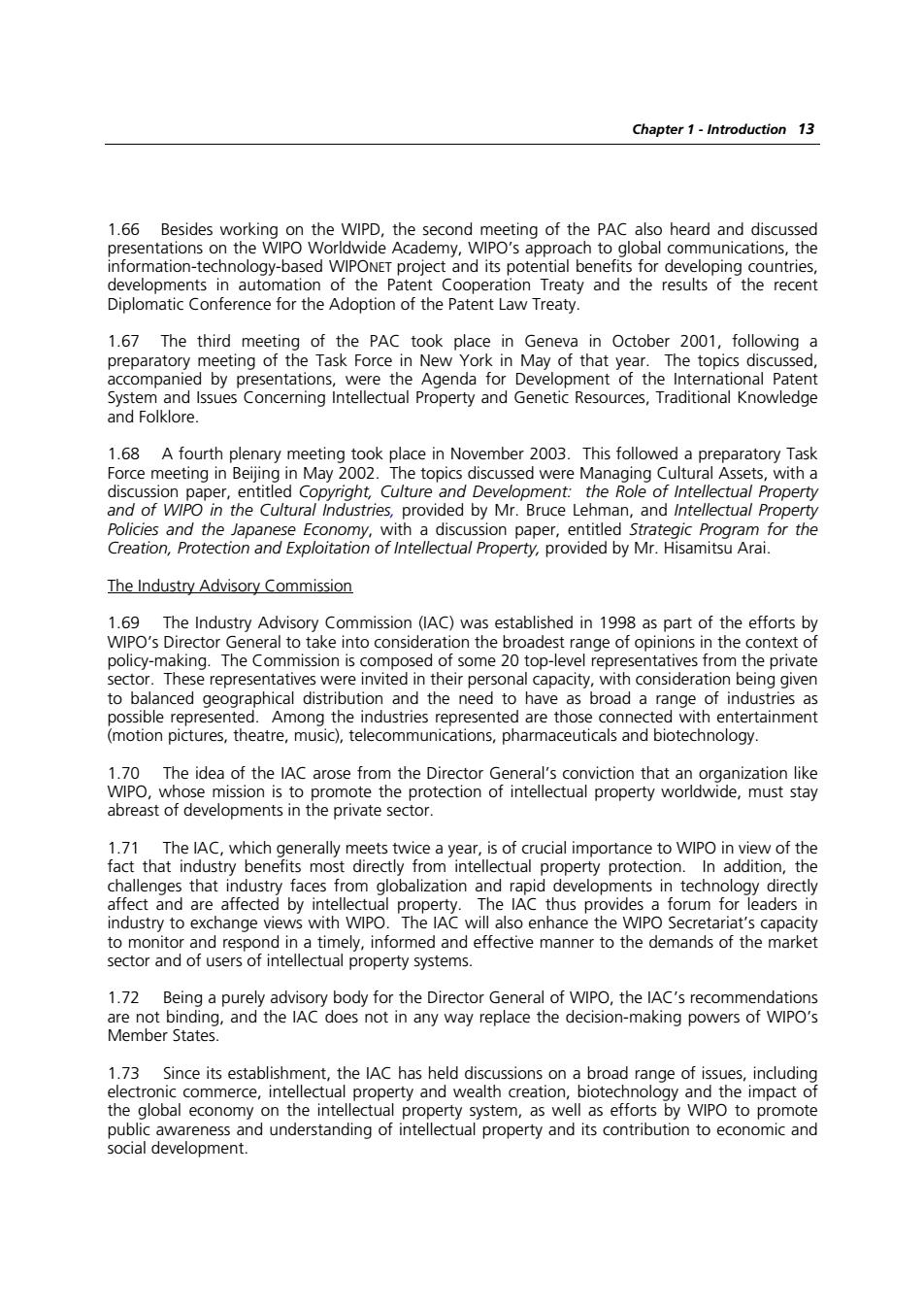
Chapter1-Introduction 13 1.66 Piomaoe echnology-based WIPONET project and its po erthiofthe atent reaand the resul following a accompanied by presentations, were the Agenda for Development of the International Paten saDnosy2n3U39Puedolaem3I3iu6uIUu3U0 1.68 A fourth enary meeting took place in November 2003.This followed a preparatory Tas dwsppet,entedC man and Intellectual Proper Omomamg or the 1.69 The Industry Advisory Commission (IAC)was established in 1998 as part of the efforts by WIPO's Directe the broadest range ions in the context ersonal capa to balanced geo graphical distribution and the need to have abreast of developments in the private sector. 1.71 The lAC which ts ance to wiPo in of the fact that industry benefits most directly from intellectual property protection. In addition,the nges that ind industry to exchange views with WIPO. The IAC will also enhance the WIPO Secretariat's capacity a timely,informed and effective manner to the demands of the market ector tellectual property system 1.72 Member States. does not in any way replace the de r-mnaking povers o 1.7 and the imac the global economy on the intellectual pr perty system,as well as efforts by WIPO to promote nd understanding of intellectual property and its contribution to economic and
Chapter 1 - Introduction 13 1.66 Besides working on the WIPD, the second meeting of the PAC also heard and discussed presentations on the WIPO Worldwide Academy, WIPO’s approach to global communications, the information-technology-based WIPONET project and its potential benefits for developing countries, developments in automation of the Patent Cooperation Treaty and the results of the recent Diplomatic Conference for the Adoption of the Patent Law Treaty. 1.67 The third meeting of the PAC took place in Geneva in October 2001, following a preparatory meeting of the Task Force in New York in May of that year. The topics discussed, accompanied by presentations, were the Agenda for Development of the International Patent System and Issues Concerning Intellectual Property and Genetic Resources, Traditional Knowledge and Folklore. 1.68 A fourth plenary meeting took place in November 2003. This followed a preparatory Task Force meeting in Beijing in May 2002. The topics discussed were Managing Cultural Assets, with a discussion paper, entitled Copyright, Culture and Development: the Role of Intellectual Property and of WIPO in the Cultural Industries, provided by Mr. Bruce Lehman, and Intellectual Property Policies and the Japanese Economy, with a discussion paper, entitled Strategic Program for the Creation, Protection and Exploitation of Intellectual Property, provided by Mr. Hisamitsu Arai. The Industry Advisory Commission 1.69 The Industry Advisory Commission (IAC) was established in 1998 as part of the efforts by WIPO’s Director General to take into consideration the broadest range of opinions in the context of policy-making. The Commission is composed of some 20 top-level representatives from the private sector. These representatives were invited in their personal capacity, with consideration being given to balanced geographical distribution and the need to have as broad a range of industries as possible represented. Among the industries represented are those connected with entertainment (motion pictures, theatre, music), telecommunications, pharmaceuticals and biotechnology. 1.70 The idea of the IAC arose from the Director General’s conviction that an organization like WIPO, whose mission is to promote the protection of intellectual property worldwide, must stay abreast of developments in the private sector. 1.71 The IAC, which generally meets twice a year, is of crucial importance to WIPO in view of the fact that industry benefits most directly from intellectual property protection. In addition, the challenges that industry faces from globalization and rapid developments in technology directly affect and are affected by intellectual property. The IAC thus provides a forum for leaders in industry to exchange views with WIPO. The IAC will also enhance the WIPO Secretariat’s capacity to monitor and respond in a timely, informed and effective manner to the demands of the market sector and of users of intellectual property systems. 1.72 Being a purely advisory body for the Director General of WIPO, the IAC’s recommendations are not binding, and the IAC does not in any way replace the decision-making powers of WIPO’s Member States. 1.73 Since its establishment, the IAC has held discussions on a broad range of issues, including electronic commerce, intellectual property and wealth creation, biotechnology and the impact of the global economy on the intellectual property system, as well as efforts by WIPO to promote public awareness and understanding of intellectual property and its contribution to economic and social development
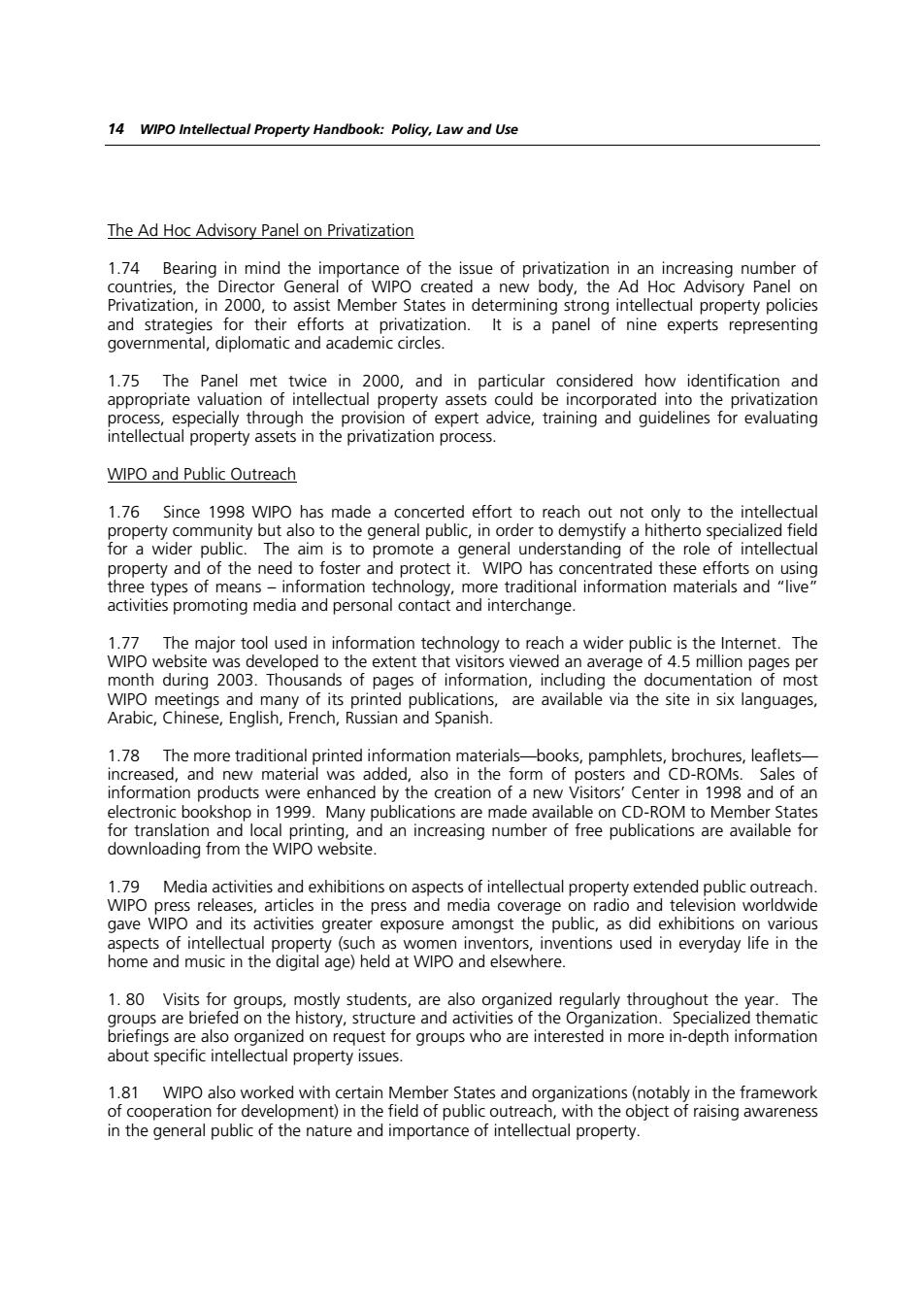
14 WIPO Intellectual Property Handbook:Policy,Law and Use The Ad Hoc Advisory Panel on Privatization 1.74 Bearing in mind the importance of the issue of privatization in an increasing number of countries,the Genera created a new body,the Ad Hoc Advisory Panel on and strate for their efforts at privatization. nine experts representing governmental,diplomatic and academic circles. 1 75 The Panel met twice in 2000 and in particular considered how identification and appropriate valuation of intellectual property assets advice,training and guidelines for eva WIPO and Public Outreach 1.76 Since 1998 WIPO has made a concerted effort to reach out not only to the intellectua nity but also to th ne general public,in order to demy stify a hit o specialized fiel perty and of the need to o foste and p tect it WIPO has concentrated t efforts on using nformation technolog The major tool used in information t chnology to reach a wider public is the Internet.The ges of info mation incudina the doc MIPO meetings and many of its printed publicatic Arabic Chinese,spanish s,are available via the site in six languages, 1.78 The more traditional printed information materials- -books,pamphlets,brochures,leaflets materia I was added.also in the form of posters and CD-ROs bookshop in 1999.Many publications are made available on CD-ROM to Membe Sta nd an increasing number of free publications are available for W7gledintiesantehbtoseonasec of intellectual propertyextended ngst the public.did 1.80 Visits for groups,mostly students,are also organized regularly throughout the year.The groups are br ed on the nistory,stru re and activitie no are about specific intellectual property issues in the general public of the nature and importance of intellectual property
14 WIPO Intellectual Property Handbook: Policy, Law and Use The Ad Hoc Advisory Panel on Privatization 1.74 Bearing in mind the importance of the issue of privatization in an increasing number of countries, the Director General of WIPO created a new body, the Ad Hoc Advisory Panel on Privatization, in 2000, to assist Member States in determining strong intellectual property policies and strategies for their efforts at privatization. It is a panel of nine experts representing governmental, diplomatic and academic circles. 1.75 The Panel met twice in 2000, and in particular considered how identification and appropriate valuation of intellectual property assets could be incorporated into the privatization process, especially through the provision of expert advice, training and guidelines for evaluating intellectual property assets in the privatization process. WIPO and Public Outreach 1.76 Since 1998 WIPO has made a concerted effort to reach out not only to the intellectual property community but also to the general public, in order to demystify a hitherto specialized field for a wider public. The aim is to promote a general understanding of the role of intellectual property and of the need to foster and protect it. WIPO has concentrated these efforts on using three types of means – information technology, more traditional information materials and “live” activities promoting media and personal contact and interchange. 1.77 The major tool used in information technology to reach a wider public is the Internet. The WIPO website was developed to the extent that visitors viewed an average of 4.5 million pages per month during 2003. Thousands of pages of information, including the documentation of most WIPO meetings and many of its printed publications, are available via the site in six languages, Arabic, Chinese, English, French, Russian and Spanish. 1.78 The more traditional printed information materials—books, pamphlets, brochures, leaflets— increased, and new material was added, also in the form of posters and CD-ROMs. Sales of information products were enhanced by the creation of a new Visitors’ Center in 1998 and of an electronic bookshop in 1999. Many publications are made available on CD-ROM to Member States for translation and local printing, and an increasing number of free publications are available for downloading from the WIPO website. 1.79 Media activities and exhibitions on aspects of intellectual property extended public outreach. WIPO press releases, articles in the press and media coverage on radio and television worldwide gave WIPO and its activities greater exposure amongst the public, as did exhibitions on various aspects of intellectual property (such as women inventors, inventions used in everyday life in the home and music in the digital age) held at WIPO and elsewhere. 1. 80 Visits for groups, mostly students, are also organized regularly throughout the year. The groups are briefed on the history, structure and activities of the Organization. Specialized thematic briefings are also organized on request for groups who are interested in more in-depth information about specific intellectual property issues. 1.81 WIPO also worked with certain Member States and organizations (notably in the framework of cooperation for development) in the field of public outreach, with the object of raising awareness in the general public of the nature and importance of intellectual property
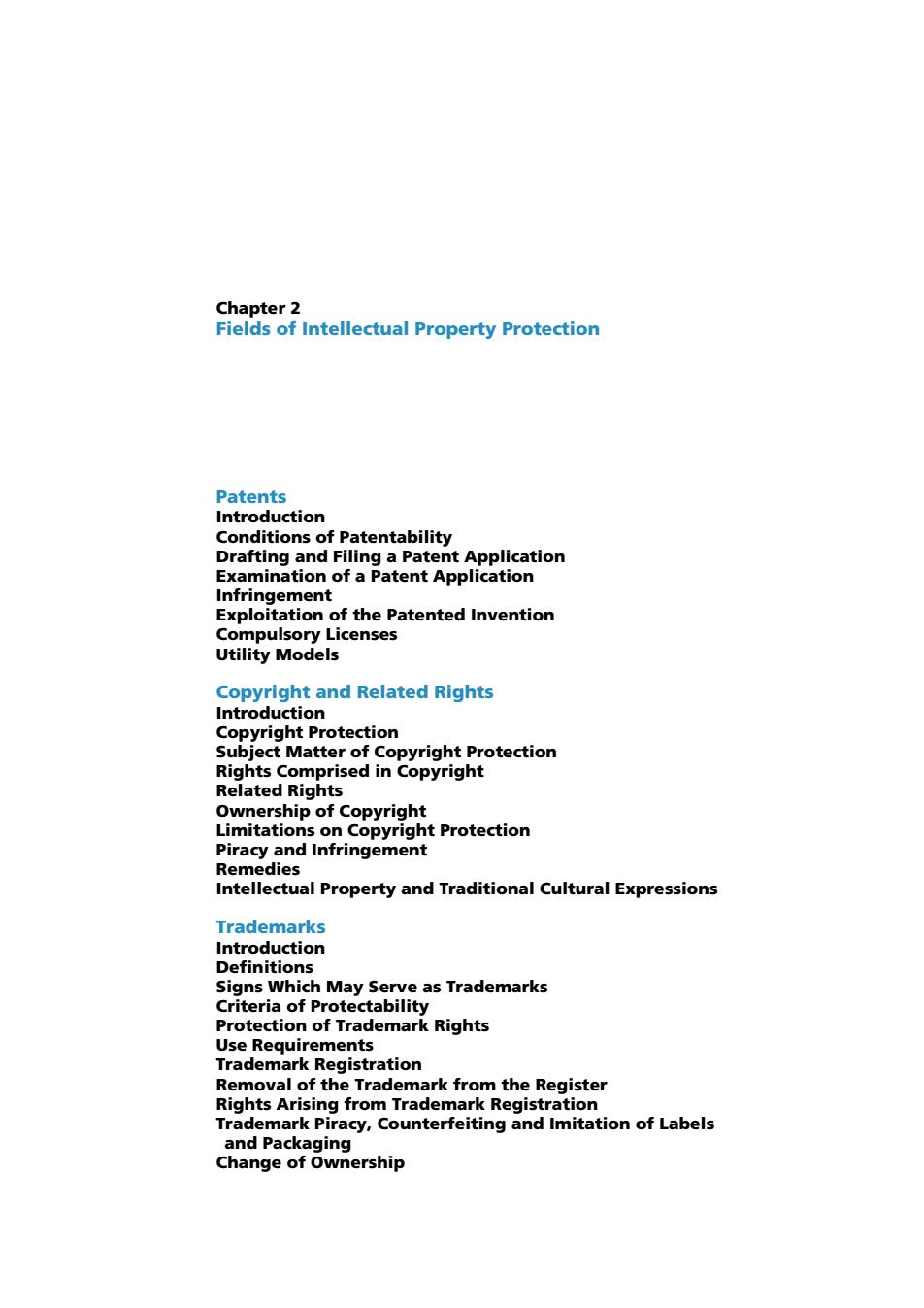
tior tions of Patentability Drafting and Filing a Patent Application of the Patented Invention Compulsory Licenses Utility Models Copvright and Related Rights Introduction Copyright Protection er c edfPeopyhgRtotection Related Rights 09 Ownership of Copyright Protection Remedies Intellectual Property and Traditional Cultural Expressions Trademarks Introduction Definitions ve as Trademarks oTrademark Rights Use Requirements Trademark Registration Re rk fron the e Register BohsnAkpagcounieenaygmietonofhbeh5 cagecf8aernhp
Chapter 2 Fields of Intellectual Property Protection Patents Introduction Conditions of Patentability Drafting and Filing a Patent Application Examination of a Patent Application Infringement Exploitation of the Patented Invention Compulsory Licenses Utility Models Copyright and Related Rights Introduction Copyright Protection Subject Matter of Copyright Protection Rights Comprised in Copyright Related Rights Ownership of Copyright Limitations on Copyright Protection Piracy and Infringement Remedies Intellectual Property and Traditional Cultural Expressions Trademarks Introduction Definitions Signs Which May Serve as Trademarks Criteria of Protectability Protection of Trademark Rights Use Requirements Trademark Registration Removal of the Trademark from the Register Rights Arising from Trademark Registration Trademark Piracy, Counterfeiting and Imitation of Labels and Packaging Change of Ownership
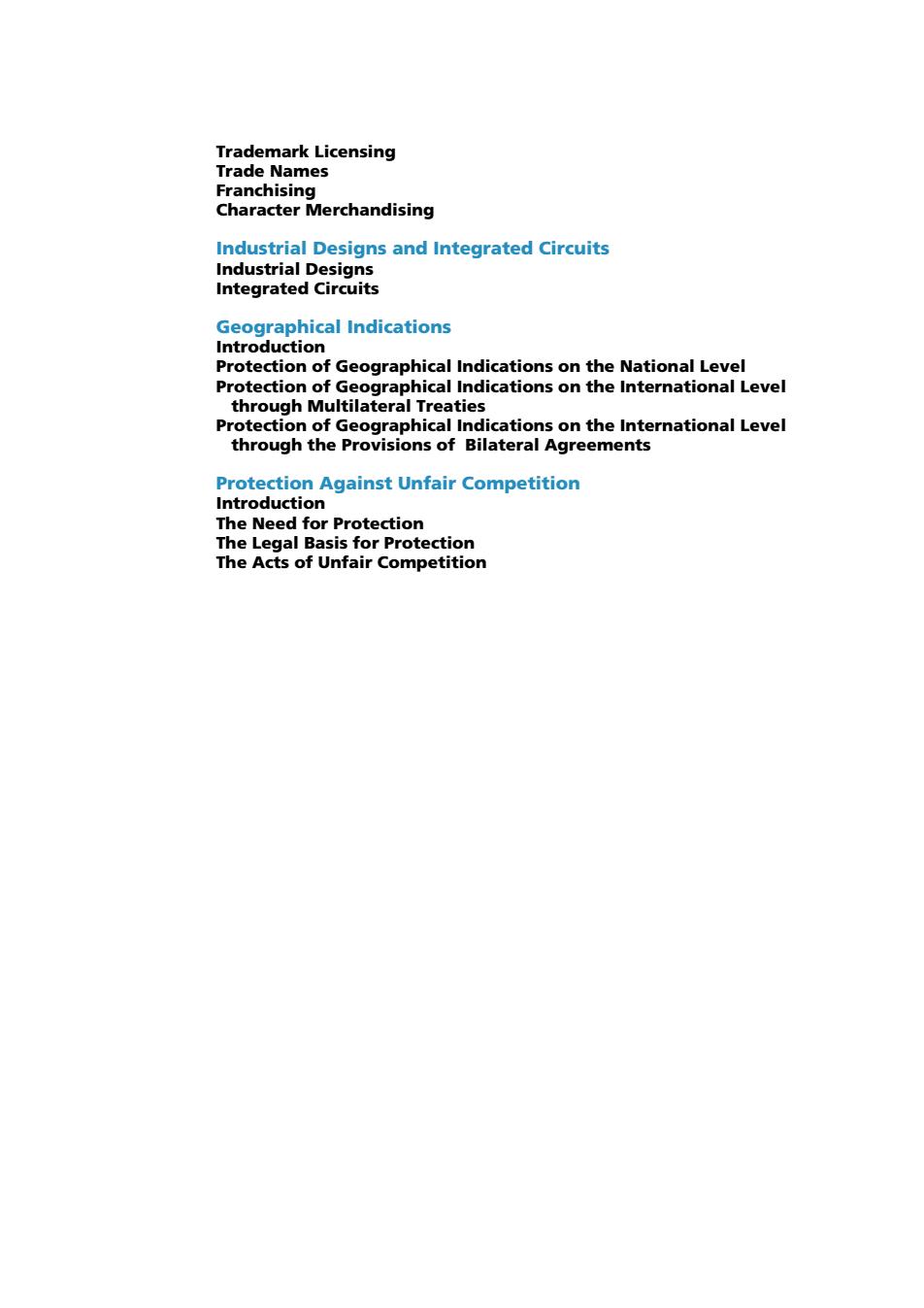
Trade ark Licensing Franchising Character Merchandising Industrial Designs and Integrated Circuits Industrial Designs Integrated Circuits phical Indications Protection of Geographical Indications on the National Level Protection of G ihntmation Leve s on the International Level through the Provisions of Bilateral Agreements Against Unfair Competition The Need for Protection
Trademark Licensing Trade Names Franchising Character Merchandising Industrial Designs and Integrated Circuits Industrial Designs Integrated Circuits Geographical Indications Introduction Protection of Geographical Indications on the National Level Protection of Geographical Indications on the International Level through Multilateral Treaties Protection of Geographical Indications on the International Level through the Provisions of Bilateral Agreements Protection Against Unfair Competition Introduction The Need for Protection The Legal Basis for Protection The Acts of Unfair Competition
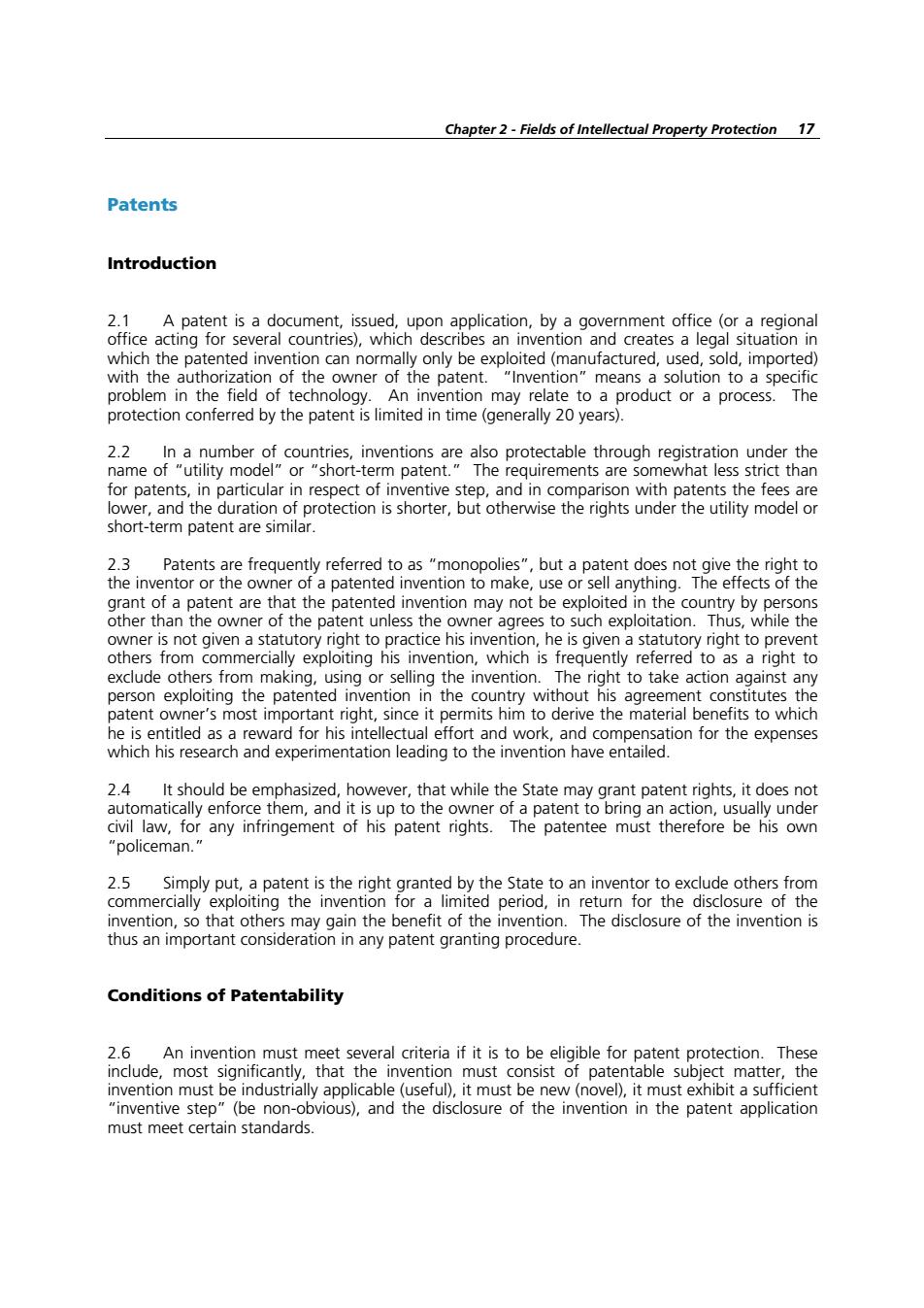
Chapter 2-Fields of Intellectual Property Protection 17 Patents Introduction patentsdocmentsedponppicio bgovemment officer which the patentedinvention can normallyonly be exploited (manufactured.used.sold.imported w他heautheratoaofethed owner of the patent. rduct or a process. therhthe patented invntion may notbe of the patent unless the o agrees to such while the exclude others from mak The eright to take actior se。exp ti pate iaht sir s to whick 2.4 It should be emphasized,however,that while the State may grant patent rights,it does no autom policeman. The disclosure of the invention is porta Conditions of Patentability An invention mu nventionm2te industrially applicable (usefu).it must be new (novel).it must a sufficiem (be e non-c ovious),and the disclosure of the invention in the patent application
Chapter 2 - Fields of Intellectual Property Protection 17 Patents Introduction 2.1 A patent is a document, issued, upon application, by a government office (or a regional office acting for several countries), which describes an invention and creates a legal situation in which the patented invention can normally only be exploited (manufactured, used, sold, imported) with the authorization of the owner of the patent. “Invention” means a solution to a specific problem in the field of technology. An invention may relate to a product or a process. The protection conferred by the patent is limited in time (generally 20 years). 2.2 In a number of countries, inventions are also protectable through registration under the name of “utility model” or “short-term patent.” The requirements are somewhat less strict than for patents, in particular in respect of inventive step, and in comparison with patents the fees are lower, and the duration of protection is shorter, but otherwise the rights under the utility model or short-term patent are similar. 2.3 Patents are frequently referred to as “monopolies”, but a patent does not give the right to the inventor or the owner of a patented invention to make, use or sell anything. The effects of the grant of a patent are that the patented invention may not be exploited in the country by persons other than the owner of the patent unless the owner agrees to such exploitation. Thus, while the owner is not given a statutory right to practice his invention, he is given a statutory right to prevent others from commercially exploiting his invention, which is frequently referred to as a right to exclude others from making, using or selling the invention. The right to take action against any person exploiting the patented invention in the country without his agreement constitutes the patent owner’s most important right, since it permits him to derive the material benefits to which he is entitled as a reward for his intellectual effort and work, and compensation for the expenses which his research and experimentation leading to the invention have entailed. 2.4 It should be emphasized, however, that while the State may grant patent rights, it does not automatically enforce them, and it is up to the owner of a patent to bring an action, usually under civil law, for any infringement of his patent rights. The patentee must therefore be his own “policeman.” 2.5 Simply put, a patent is the right granted by the State to an inventor to exclude others from commercially exploiting the invention for a limited period, in return for the disclosure of the invention, so that others may gain the benefit of the invention. The disclosure of the invention is thus an important consideration in any patent granting procedure. Conditions of Patentability 2.6 An invention must meet several criteria if it is to be eligible for patent protection. These include, most significantly, that the invention must consist of patentable subject matter, the invention must be industrially applicable (useful), it must be new (novel), it must exhibit a sufficient “inventive step” (be non-obvious), and the disclosure of the invention in the patent application must meet certain standards